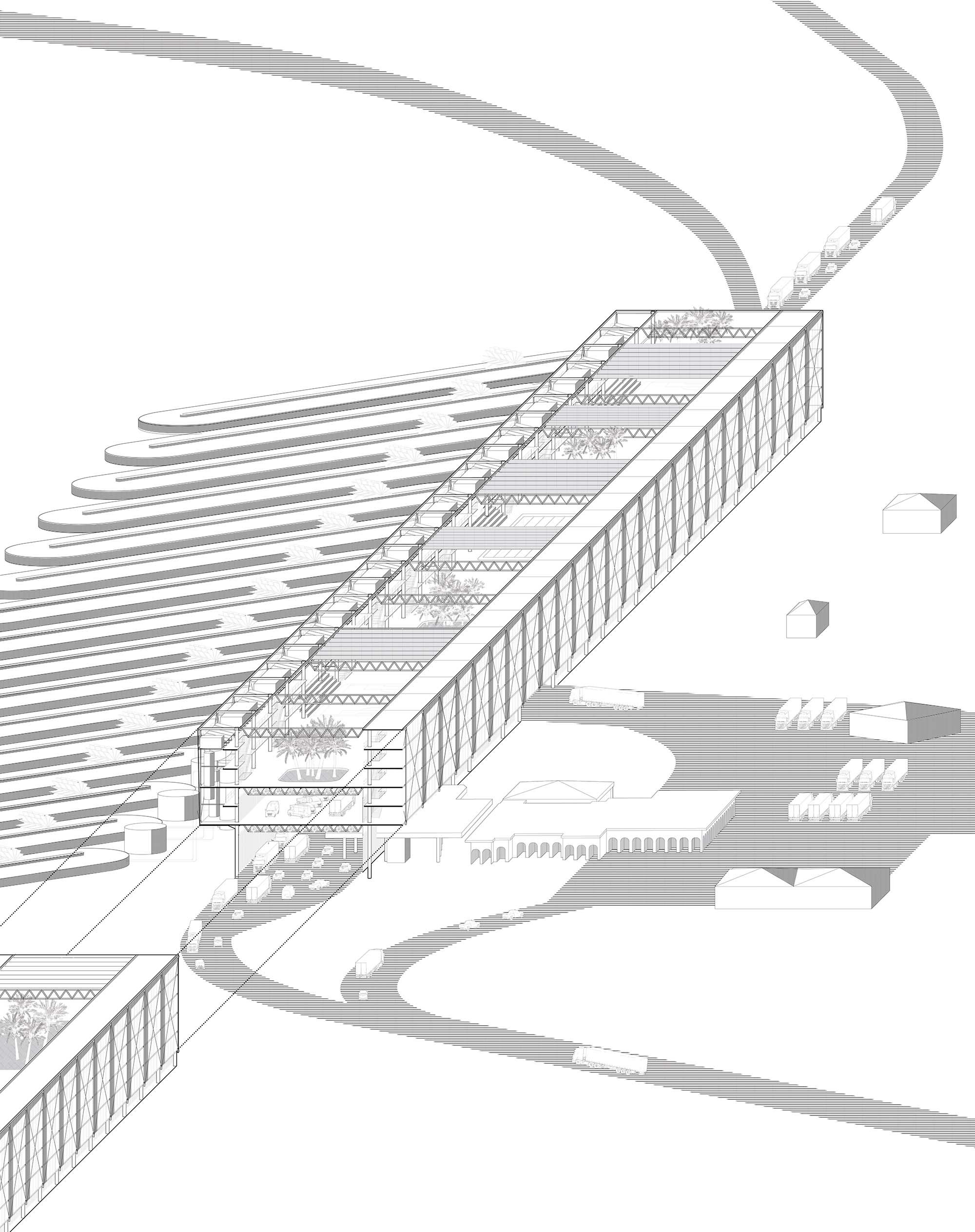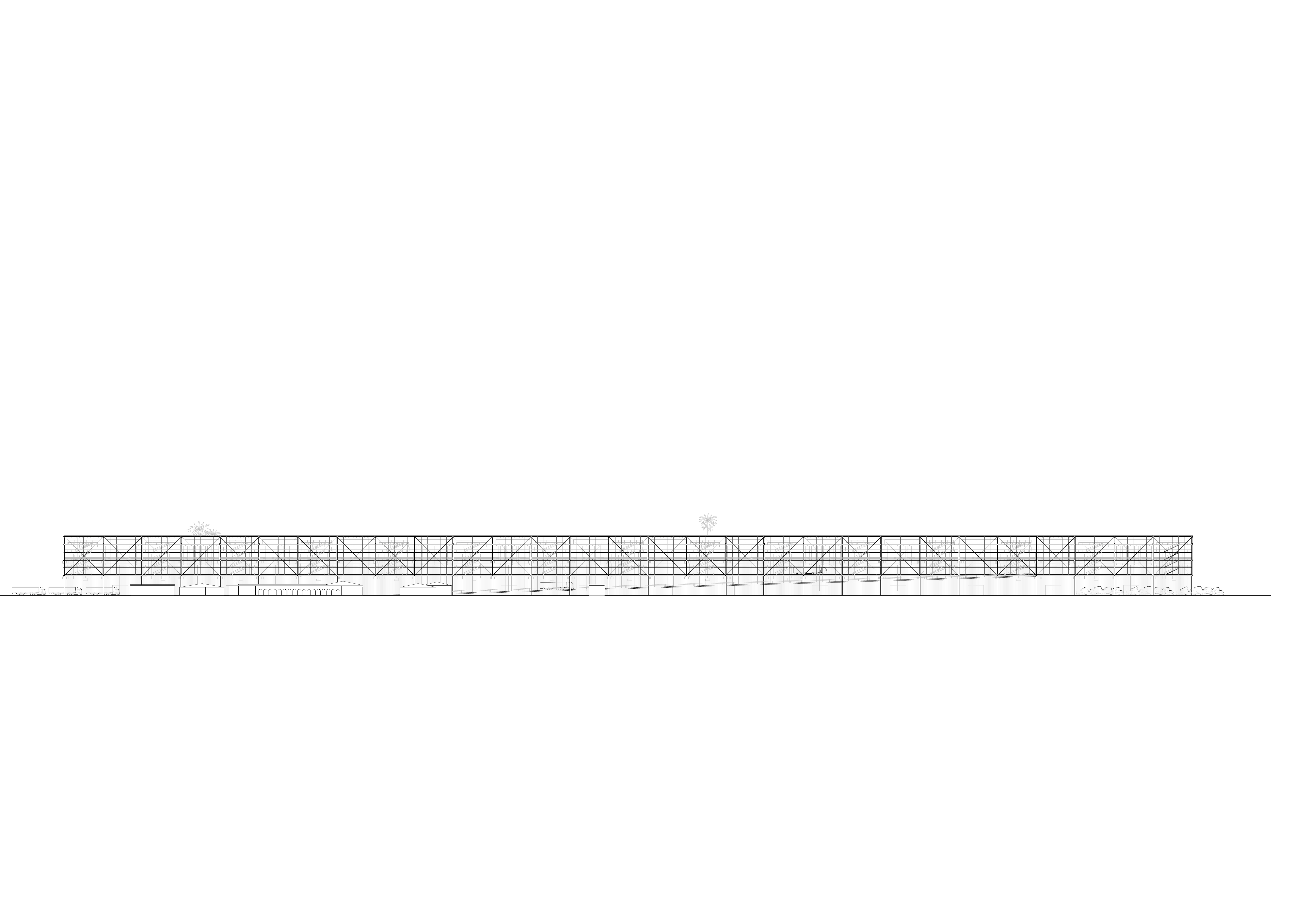







Idling at the Border
Presidio—a small Texas town of 5,000 people located 250 miles southeast of El Paso, has recently started to change due to the increase of its daily border bureaucratic processes. Traditionally, Los Indios, in southeast Texas, was the main entry point for transmigrantes, importers who transport second-hand vehicles from the U.S. to Central America via Mexico. However, in 2020, Presidio was identified as a new potential route. Transmigrantes typically spend two to three nights at the border, waiting for customs to process the necessary paperwork and inventories for each vehicle they have acquired.
Simultaneously, some areas of West Texas, along with regions in southern California and Florida, have become ideal locations to cultivate spirulina algae for human consumption. The spirulina market is booming in the U.S., driven by its popularity as a nutrient-dense, trendy food source, sold at expensive prices in cosmopolitan cities. Its global market, valued at $542.52 million in 2022, is projected to more than double by 2030. However, the infrastructure and ingredients needed for spirulina growth are very specific —it requires large water raceways (ponds), abundant sunlight, and considerable amounts of wastewater, and CO₂—unconventional resources that can make this process both extremely sustainable and regionally unique.
Presidio’s municipal water system serves most residents, sourcing groundwater from the West Texas Bolson Aquifer. However, many plots along Highway 67, where transmigrantes stop, lack access to this system. The Texas Water Development Board recently approved $4.6 million for water and wastewater improvements in Presidio County, allowing for the construction of a few elevated tanks for clean water storage and distribution but leaving these same areas along Highway 67 without access to a sewage system. Transmigrantes, thus, rely on self-installed septic tanks for wastewater collection. This solution not only puts the Aquifer’s water quality at risk (due to infiltration of wastewater from the septic tanks) but also portrays a violently unfair system that does not protect the protagonists of the town’s recent economical reactivation.
Let’s imagine, then, a megastructure that seeks to merge the logistical needs of transmigrantes with the demands of the growing spirulina industry. Located at the Port of Entry, literally hovering over Highway 67 and the U.S. Customs facilities, the 500 m long megastructure serves as a rest stop and oasis for transmigrantes. It offers numerous parking spaces for large sized vehicles on its 1st floor, and rooms, kitchens, pools, soccer fields, and gardens on the second floor, providing a safe, and comfortable space for the 2-3 night stay.
The CO2 constantly emitted by idling vehicles at Presidio’s U.S. customs, a byproduct of bureaucratic inefficiencies, is captured using tunnel turbines and directly injected into fifteen large, covered raceways with water flowing centrifugally to grow spirulina under the Texas sun. The raceways are filled with wastewater collected from the bathrooms and kitchens within the megastructure, directly dependent on the usage by transmigrantes during their stay. The ground floor is defined by the algae raceways connected to the megastructure with pipes on its North side, competing in plan with the existing U.S. Customs infrastructure on its South side. The megastructure touches the ground lightly, resting on pilotis to avoid flooding from Rio Grande and minimize its contact with American soil. Although built on U.S. land, the megastructure is accessible only to non-resident aliens, ensuring its operation as a distinct, separate entity.
Ultimately, the megastructure functions as a complex system of recycling and production, thriving within the bureaucratic processes and capitalist structures of the U.S. border economy. By absorbing waste, producing valuable products for the self-sufficiency of transmigrantes, and adapting to the inefficiencies around it, it becomes a sophisticated parasite, exploiting and thriving off the very systems it serves.
Harvard GSD 2023
Supervisor: Regine Leibinger and Karen Stein
Presidio—a small Texas town of 5,000 people located 250 miles southeast of El Paso, has recently started to change due to the increase of its daily border bureaucratic processes. Traditionally, Los Indios, in southeast Texas, was the main entry point for transmigrantes, importers who transport second-hand vehicles from the U.S. to Central America via Mexico. However, in 2020, Presidio was identified as a new potential route. Transmigrantes typically spend two to three nights at the border, waiting for customs to process the necessary paperwork and inventories for each vehicle they have acquired.
Simultaneously, some areas of West Texas, along with regions in southern California and Florida, have become ideal locations to cultivate spirulina algae for human consumption. The spirulina market is booming in the U.S., driven by its popularity as a nutrient-dense, trendy food source, sold at expensive prices in cosmopolitan cities. Its global market, valued at $542.52 million in 2022, is projected to more than double by 2030. However, the infrastructure and ingredients needed for spirulina growth are very specific —it requires large water raceways (ponds), abundant sunlight, and considerable amounts of wastewater, and CO₂—unconventional resources that can make this process both extremely sustainable and regionally unique.
Presidio’s municipal water system serves most residents, sourcing groundwater from the West Texas Bolson Aquifer. However, many plots along Highway 67, where transmigrantes stop, lack access to this system. The Texas Water Development Board recently approved $4.6 million for water and wastewater improvements in Presidio County, allowing for the construction of a few elevated tanks for clean water storage and distribution but leaving these same areas along Highway 67 without access to a sewage system. Transmigrantes, thus, rely on self-installed septic tanks for wastewater collection. This solution not only puts the Aquifer’s water quality at risk (due to infiltration of wastewater from the septic tanks) but also portrays a violently unfair system that does not protect the protagonists of the town’s recent economical reactivation.
Let’s imagine, then, a megastructure that seeks to merge the logistical needs of transmigrantes with the demands of the growing spirulina industry. Located at the Port of Entry, literally hovering over Highway 67 and the U.S. Customs facilities, the 500 m long megastructure serves as a rest stop and oasis for transmigrantes. It offers numerous parking spaces for large sized vehicles on its 1st floor, and rooms, kitchens, pools, soccer fields, and gardens on the second floor, providing a safe, and comfortable space for the 2-3 night stay.
The CO2 constantly emitted by idling vehicles at Presidio’s U.S. customs, a byproduct of bureaucratic inefficiencies, is captured using tunnel turbines and directly injected into fifteen large, covered raceways with water flowing centrifugally to grow spirulina under the Texas sun. The raceways are filled with wastewater collected from the bathrooms and kitchens within the megastructure, directly dependent on the usage by transmigrantes during their stay. The ground floor is defined by the algae raceways connected to the megastructure with pipes on its North side, competing in plan with the existing U.S. Customs infrastructure on its South side. The megastructure touches the ground lightly, resting on pilotis to avoid flooding from Rio Grande and minimize its contact with American soil. Although built on U.S. land, the megastructure is accessible only to non-resident aliens, ensuring its operation as a distinct, separate entity.
Ultimately, the megastructure functions as a complex system of recycling and production, thriving within the bureaucratic processes and capitalist structures of the U.S. border economy. By absorbing waste, producing valuable products for the self-sufficiency of transmigrantes, and adapting to the inefficiencies around it, it becomes a sophisticated parasite, exploiting and thriving off the very systems it serves.
Harvard GSD 2023
Supervisor: Regine Leibinger and Karen Stein